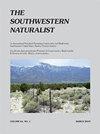DIET COMPARISON BETWEEN JUVENILE AND ADULT INVASIVE CHANNEL CATFISH (ICTALURUS PUNCTATUS) IN THE SAN JUAN RIVER
IF 0.2
4区 环境科学与生态学
Q4 Agricultural and Biological Sciences
引用次数: 2
Abstract
Abstract Extensive efforts to reduce the population of invasive channel catfish (Ictalurus punctatus) in the San Juan River, USA, have increased the relative abundance of juveniles, with little understanding about potential trophic interactions between these juveniles and native fishes. Gut contents of juvenile (<250 mm total length) and adult (≥300 mm) channel catfish in the San Juan River were collected in the summer and fall of 2018 and 2019 to quantify ontogenetic change in diet. Juveniles primarily consumed aquatic insects and terrestrial plants, whereas adults primarily consumed fewer aquatic insects and significantly more plants and fish. Logistic regression confirmed these diet shifts as a function of total length and suggest the nature of interactions between channel catfish and native fishes can change with life stage: from potential competitor for aquatic invertebrates, to competitor and predator. Resumen Esfuerzos extensos para reducir la población de bagres de canal invasores (Ictalurus punctatus) en el río San Juan, EE.UU., han aumentado la abundancia relativa de juveniles, con poco entendimiento sobre las posibles interacciones tróficas entre estos juveniles y peces nativos. Los contenidos del estómago de bagres de canal juveniles (<250 mm longitud total) y adultos (≥300 mm) en el río San Juan fueron colectados en el verano y otoño del 2018 y 2019 para cuantificar el cambio ontogenético en la dieta. Los juveniles consumieron principalmente insectos acuáticos y plantas terrestres, mientras que los adultos principalmente consumieron menos insectos acuáticos y significativamente más plantas y peces. La regresión logística confirmó estos cambios en la dieta como una función de la longitud total y sugiere que la naturaleza de las interacciones entre los bagres de canal y los peces nativos puede cambiar con la fase de la vida: de un competidor potencial para los invertebrados acuáticos, a competidor y depredador.三卷河幼年和成年入侵性斑节叉尾鱼的日粮比较
为了减少美国圣胡安河(San Juan River)入侵河道鲶鱼(Ictalurus punctatus)的数量,人们进行了大量的努力,增加了幼鱼的相对丰度,但人们对这些幼鱼与本地鱼类之间潜在的营养相互作用知之甚少。本研究于2018年和2019年夏秋采集圣胡安河河道鲶鱼幼鱼(总长度<250 mm)和成鱼(≥300 mm)的肠道内容物,以量化饮食中的个体发生变化。幼鱼主要食用水生昆虫和陆生植物,而成鱼主要食用较少的水生昆虫和大量的植物和鱼类。逻辑回归证实了这些饮食变化是总长度的函数,并表明通道鲶鱼和本地鱼类之间相互作用的性质可以随着生命阶段的变化而变化:从水生无脊椎动物的潜在竞争对手,到竞争对手和捕食者。[续篇]运河入侵物种的扩展与还原研究población运河入侵物种(斑点伊塔卢斯)的研究río圣胡安,美国。(1)青少年相对丰富,青少年相对丰富,未成年人相对丰富,未成年人相对丰富,未成年人相对丰富,未成年人相对丰富,未成年人相对丰富,未成年人相对丰富,未成年人相对丰富。Los conidos del estómago de bagres de canal幼鱼(总纵长<250 mm)和成虫(≥300 mm) en el río圣胡安fueron收集器en el verano y otoño del 2018 y 2019 para conidicar el cambio ontogenacimtico en la dieta。幼虫主要消费昆虫acuáticos通过植物地,幼虫主要消费昆虫acuáticos通过植物地,幼虫主要消费昆虫acuáticos通过植物地。这就是regresión logística confirmó estos cambios en La dieta como una función de La纵向总通过sugiere que La naturaleza de las interacciciones entres los bagres de canal通过los peces native ' s puede cambiar con La fase de La vida: de竞争对手潜在para los invertebros acuáticos,一个竞争对手的掠夺者。
本文章由计算机程序翻译,如有差异,请以英文原文为准。
求助全文
约1分钟内获得全文
求助全文
来源期刊

Southwestern Naturalist
环境科学-生态学
CiteScore
0.50
自引率
50.00%
发文量
47
审稿时长
18-36 weeks
期刊介绍:
The Southwestern Naturalist (a publication of the Southwestern Association of Naturalists since 1953) is an international journal (published quarterly) that reports original and significant research in any field of natural history. This journal promotes the study of plants and animals (living and fossil) in the multinational region that includes the southwestern United States, Mexico, and Central America. Appropriate submission of manuscripts may come from studies conducted in the countries of focus or in regions outside this area that report significant findings relating to biota occurring in the southwestern United States, Mexico, and Central America. Publication is in English, and manuscripts may be feature articles or notes. Feature articles communicate results of completed scientific investigations, while notes are reserved for short communications (e.g., behavioral observations, range extensions, and other important findings that do not in themselves constitute a comprehensive study). All manuscripts (feature articles and notes) require an abstract in both English and Spanish.
 求助内容:
求助内容: 应助结果提醒方式:
应助结果提醒方式:


